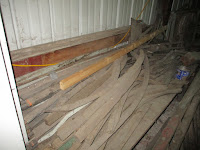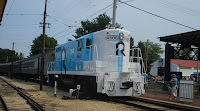The CA&E had its own system for portable headlights, which cannot be interchanged with anything else at IRM. The main parts of the circuit on each car are the headlight switch and fuse in the electrical cabinet, the resistor box under the car, and a DPDT switch at each end in the ceiling above the motorman. The headlight has two leads, connected across the bulb. One plug is white and the other is black, and these go into two receptacles in the car, labeled B and D (for bright and dim).
You will observe that the direction of current is reversed when switching from bright to dim. The reason for this has to do with arc headlights, explained below. It makes no difference with incandescent bulbs, of course.
However, the headlights were later modified by adding a small resistor to the headlight, which grounds through the case. This has the effect of making "dim" somewhat dimmer. But this resistor can be removed or disconnected, so that the headlight does not ground through the case in either position, and so that it doesn't matter if the headlight leads are switched. This change thus makes the system safer. Some but not all of our available CA&E headlights have been thus modified. In any case, as a general safety precaution all crews should be careful not to handle a headlight or even open the train door when the lamp is on. On the North Shore cars this is especially important.
The DPDT switch is enclosed in a metal casting that looks like this:
In this picture the switch is in the center off position. Inside the casting:
I believe most of the wood cars originally had the receptacles for the headlight plugs located one on either side of the train door, as seen here. In our collection, the 308 and 309 are still this way.
But later, blocks with two receptacles were mounted to one side, and this is the way all of the steel cars are arranged.
In fact, we have a couple of spare blocks from Wheaton in our collection.
The main cause of system failure, other than a bulb burning out, is the failure of one or more resistors in the box under the car.
Typical Results for 600V Trolley Voltage
-
|
Dim
|
Bright
|
Voltage
across bulb
|
60V
|
100V
|
Voltage
across box
|
540V
|
500V
|
Current
|
2.7A
|
4.0A
|
Resistance
across box
|
200Ω
|
125Ω
|
Resistance
per tube
|
40Ω
|
42Ω
|
Power
dissipated per tube
|
300W
|
650W
|
Power
dissipated in bulb
|
160W
|
400W
|
Note: Five
tubes in series when dim, three tubes when bright.
Of course, these values may vary depending upon the particular headlight bulb.
CARBON ARC HEADLIGHTS
Carbon arc lamps operate by starting a spark between two carbon electrodes. The spark continues by allowing a current between the electrodes due to the generation of a hydrocarbon gas, which provides a very intense light. The carbon arc lamp is generally a pretty rugged and reliable device, which does not require a vacuum tube, but it is more complicated, and the carbon electrodes are gradually consumed as the lamp operates.
When a carbon arc lamp is operated on DC, the positive carbon is consumed about twice as fast as the negative one, and a concave pit is developed in the end of the positive carbon, known as the crater. The crater is very hot, and most of the light is generated by this crater. For general illumination, the positive carbon would be placed directly above the gap, as shown below in Fig. 238. But for a searchlight or headlight, the carbons would usually be placed at an angle, as shown in Fig. 239, to direct the light in the desired direction. Of course, in a headlight the parabolic reflector is placed to focus the light also. (Fig. 240 shows an AC arc lamp, which doesn't concern us here.)
When the headlight is switched to dim, the direction of the current is reversed, and this makes the upper carbon negative in Fig. 239. The result is to make the rate at which the carbons are consumed more equal, and also to diffuse the light being generated somewhat.
The mechanism for a carbon arc lamp was rather complicated, but I will present a simplified explanation. The upper carbon is held in a movable holder, which is adjusted by two solenoids acting in opposite directions. There is a solenoid for lifting the carbon, wired in series with the arc, and a solenoid for pulling it down, wired in parallel with the arc. These are known as the series solenoid and shunt solenoid, respectively. There must also be a resistor in series with the lamp when it is operated from a constant-voltage source, such as on an electric car. And the lamp has a dash pot, to slow the motion of the holder.

When the lamp is off, the upper carbon drops by gravity until it touches the lower carbon. In this case, there is no resistance between the two elements, and when the lamp is turned on, maximum current flows through the series solenoid and through the carbons. The series solenoid then starts to raise the upper carbon, starting the arc. As the arc widens, the voltage across it increases, and this voltage is applied to the shunt solenoid. The downward force exerted by the shunt solenoid therefore increases until the net force is zero, and the upper carbon remains in place, with a fixed voltage and current. As the carbons are slowly eaten away, the arc widens, the voltage across it increases, and the solenoids automatically adjust the gap. If the power is turned off, as may often happen on an electric car (especially if you have third-rail gaps), gravity once more causes the upper carbon to drop down, and the process repeats.
I can only imagine everybody was glad when incandescent headlight bulbs came along.
Reference: Practical Applied Electricity by Moreton, 1911





























































